2024届高考英语二轮复习语法填空专题之谓语动词课件(共45张PPT)
文档属性
| 名称 | 2024届高考英语二轮复习语法填空专题之谓语动词课件(共45张PPT) |  | |
| 格式 | pptx | ||
| 文件大小 | 5.5MB | ||
| 资源类型 | 教案 | ||
| 版本资源 | 人教版(2019) | ||
| 科目 | 英语 | ||
| 更新时间 | 2024-04-17 11:58:44 | ||
图片预览

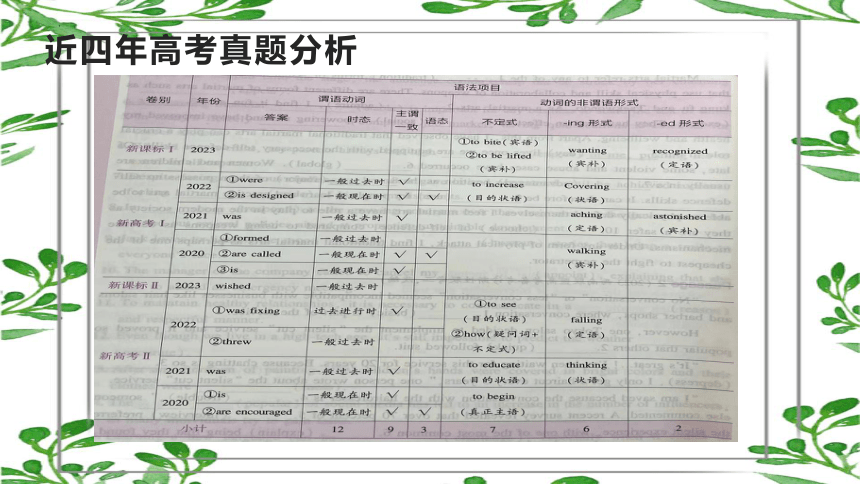
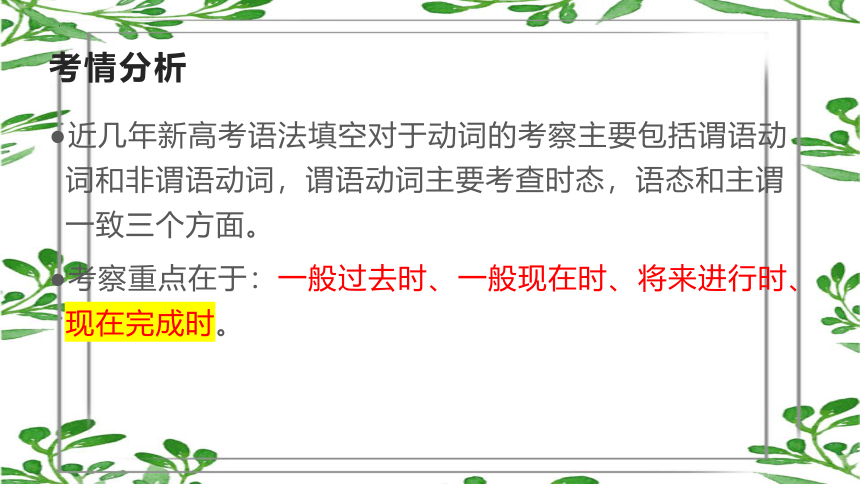
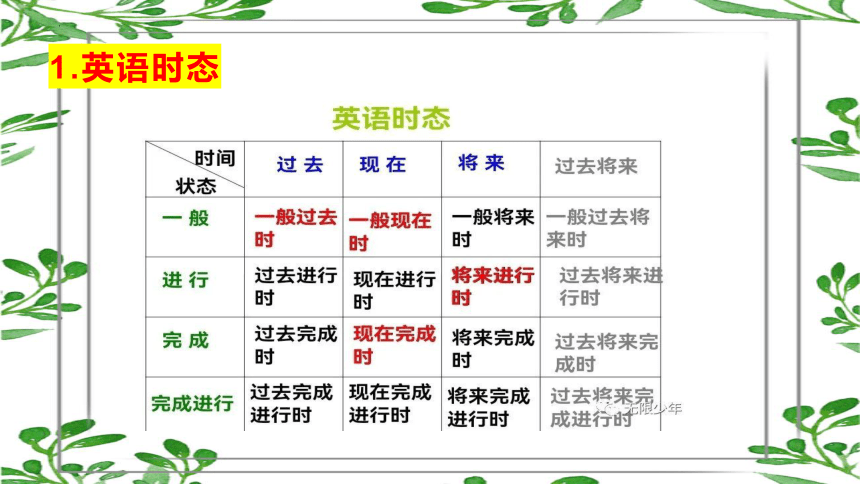
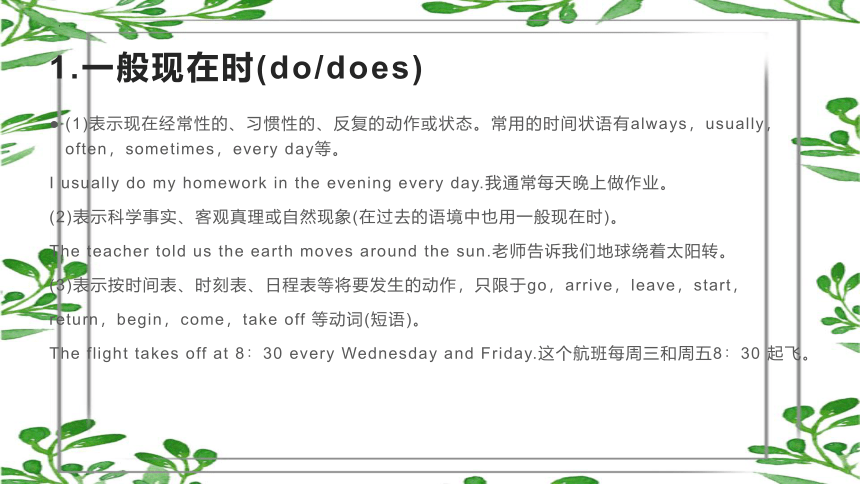
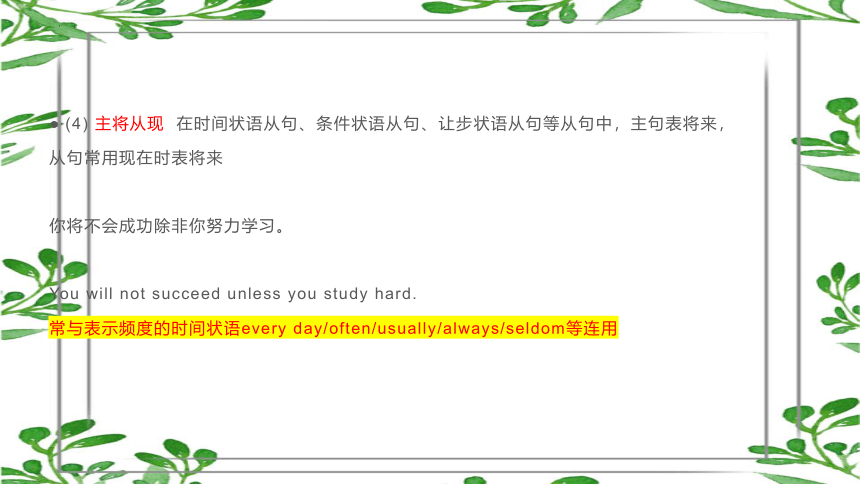
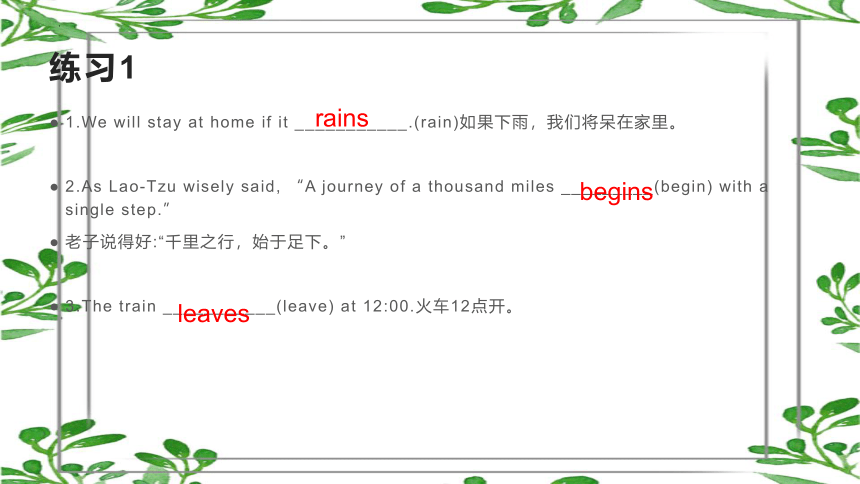
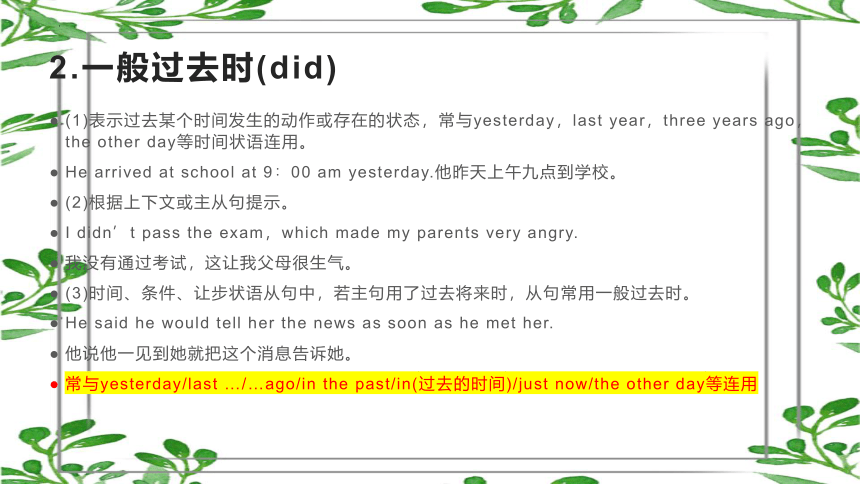
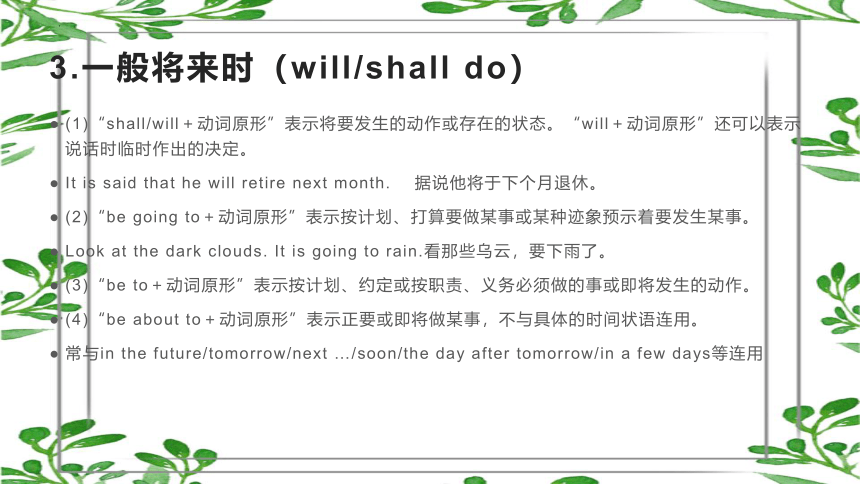
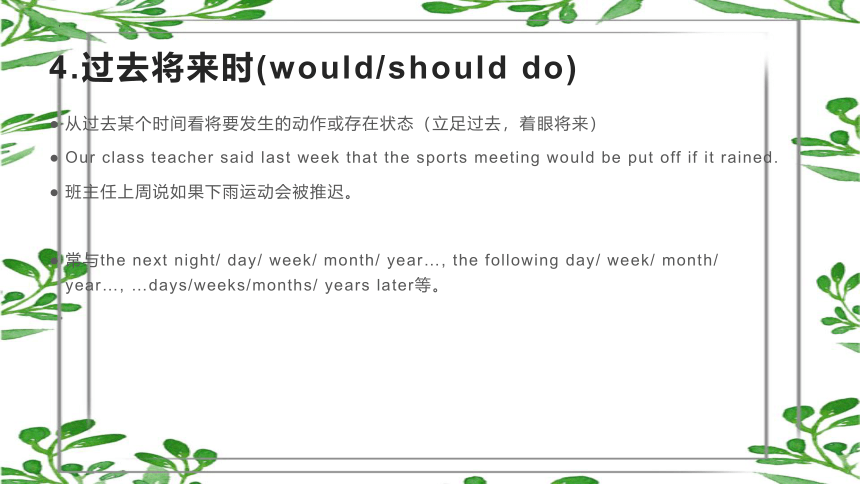

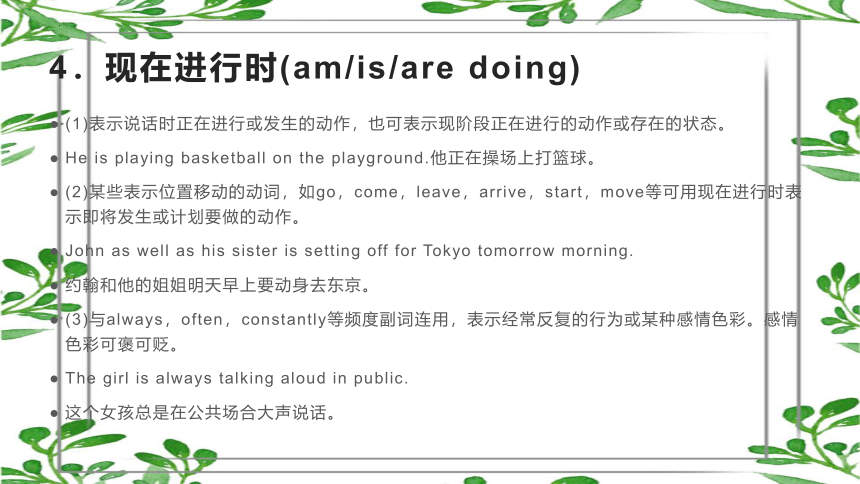
文档简介
(共45张PPT)
语法填空之谓语动词
近四年高考真题分析
考情分析
近几年新高考语法填空对于动词的考察主要包括谓语动词和非谓语动词,谓语动词主要考查时态,语态和主谓一致三个方面。
考察重点在于:一般过去时、一般现在时、将来进行时、现在完成时。
1.英语时态
1.一般现在时(do/does)
(1)表示现在经常性的、习惯性的、反复的动作或状态。常用的时间状语有always,usually,often,sometimes,every day等。
I usually do my homework in the evening every day.我通常每天晚上做作业。
(2)表示科学事实、客观真理或自然现象(在过去的语境中也用一般现在时)。
The teacher told us the earth moves around the sun.老师告诉我们地球绕着太阳转。
(3)表示按时间表、时刻表、日程表等将要发生的动作,只限于go,arrive,leave,start,
return,begin,come,take off 等动词(短语)。
The flight takes off at 8∶30 every Wednesday and Friday.这个航班每周三和周五8∶30 起飞。
(4) 主将从现 在时间状语从句、条件状语从句、让步状语从句等从句中,主句表将来,
从句常用现在时表将来
你将不会成功除非你努力学习。
You will not succeed unless you study hard.
常与表示频度的时间状语every day/often/usually/always/seldom等连用
练习1
1.We will stay at home if it ___________.(rain)如果下雨,我们将呆在家里。
2.As Lao-Tzu wisely said, “A journey of a thousand miles _________(begin) with a single step.”
老子说得好:“千里之行,始于足下。”
3.The train ___________(leave) at 12:00.火车12点开。
rains
begins
leaves
2.一般过去时(did)
(1)表示过去某个时间发生的动作或存在的状态,常与yesterday,last year,three years ago,the other day等时间状语连用。
He arrived at school at 9∶00 am yesterday.他昨天上午九点到学校。
(2)根据上下文或主从句提示。
I didn’t pass the exam,which made my parents very angry.
我没有通过考试,这让我父母很生气。
(3)时间、条件、让步状语从句中,若主句用了过去将来时,从句常用一般过去时。
He said he would tell her the news as soon as he met her.
他说他一见到她就把这个消息告诉她。
常与yesterday/last …/…ago/in the past/in(过去的时间)/just now/the other day等连用
3.一般将来时(will/shall do)
(1)“shall/will+动词原形”表示将要发生的动作或存在的状态。“will+动词原形”还可以表示说话时临时作出的决定。
It is said that he will retire next month. 据说他将于下个月退休。
(2)“be going to+动词原形”表示按计划、打算要做某事或某种迹象预示着要发生某事。
Look at the dark clouds. It is going to rain.看那些乌云,要下雨了。
(3)“be to+动词原形”表示按计划、约定或按职责、义务必须做的事或即将发生的动作。
(4)“be about to+动词原形”表示正要或即将做某事,不与具体的时间状语连用。
常与in the future/tomorrow/next …/soon/the day after tomorrow/in a few days等连用
4.过去将来时(would/should do)
从过去某个时间看将要发生的动作或存在状态(立足过去,着眼将来)
Our class teacher said last week that the sports meeting would be put off if it rained.
班主任上周说如果下雨运动会被推迟。
常与the next night/ day/ week/ month/ year…, the following day/ week/ month/ year…, …days/weeks/months/ years later等。
练习2
1.The curtains are about to open,and in a few minutes the action and dialogue _________________(tell) you the story.
2.While running regularly can’t make you live forever,the review says it ____(be) more effective at lengthening life than walking,cycling or swimming.
3.We_________(hire) our bikes from the rental place at the South Gate.My bike was old and shaky but did the job.(2021·全国甲)
will tell
is
hired
4.现在进行时(am/is/are doing)
(1)表示说话时正在进行或发生的动作,也可表示现阶段正在进行的动作或存在的状态。
He is playing basketball on the playground.他正在操场上打篮球。
(2)某些表示位置移动的动词,如go,come,leave,arrive,start,move等可用现在进行时表示即将发生或计划要做的动作。
John as well as his sister is setting off for Tokyo tomorrow morning.
约翰和他的姐姐明天早上要动身去东京。
(3)与always,often,constantly等频度副词连用,表示经常反复的行为或某种感彩。感彩可褒可贬。
The girl is always talking aloud in public.
这个女孩总是在公共场合大声说话。
常与now,right now,at present,at this moment,these days,all the time等;此外,Look!,Listen!,Be quiet!也常见于现在进行时的语境中。
注意:
近期特定的计划、安排,有时可以更改;
一般只限于go, come, leave, start, stop, arrive, begin, return, open, close等表示动作趋向性或移动意义的词;
明天11点我老公会启程去往长沙。
My husband is leaving for Changsha at 11 o 'clock tomorrow.
5.过去进行时(was/were doing)
(1)表示过去某一时刻正在发生的动作或过去某一个阶段内一直在进行的动作。
Mrs Green was preparing lunch at eleven this morning.今天上午11点格林太太正准备午餐。
(2)表示动作在另一个过去的动作发生时正在进行,常与when,while引导的时间状语从句连用。
The teacher came in while the boy was reading a novel.那个男孩正在读小说时老师进来了
(3)一些非延续性动词可用过去进行时表示过去按计划或安排将要发生的动作,常见动词有go,come,leave,start,arrive。
She asked him whether he was coming back for supper.
她问他是否要回来吃晚饭。
6.将来进行时(will be doing)
表示将来某一时刻或某一段时间里正在进行的动作,常与一些标志性的时间状语连用。
Don’t phone me between 5 and 6.We’ll be having dinner then.
不要在五点至六点之间给我打电话,那时我们在吃晚饭。
练习3
1.She ___________(play) with the cellphone when her boss walked into the office.
2.Next Friday I will go to another concert.They ___________(play) something by Mozart at that time.
3.—Hi,let’s go skating.
—Sorry,I’m busy right now.I ___________(fill) in an application form for a new job.
was playing
will be playing
am filling
7.现在完成时(重点)(has/have done)
(1)表示过去发生的事情对现在产生的影响或结果。常用的状语有already,ever,just(刚刚),yet等。
He has turned off the light.(=The light is off now.) 他已经关灯了。
(2)表示一个动作开始于过去,一直持续到现在。常与之连用的时间状语有lately,recently,until now,ever since,in the last(past) few days/years,up to now,so far等。
In the past few years,great changes have taken place in my hometown.
在过去的几年里,我的家乡发生了巨大变化。
(3)下列句型中常用现在完成时。
This/That/It is the first/second/...time that+现在完成时
This/That/It is the best/finest/most interesting/...+名词+that+现在完成时
8.过去完成时(had done)
(1)表示在过去某一时间以前已经完成的动作。常见的时间状语有by+过去时间点,by the end of+过去时间点,by the time+从句,until/before/since+过去时间点或从句。
I had put away my cellphone before my father came back.
(2)在hardly/scarcely...when...,no sooner...than...等表示“一……就……”的句式中,主句常用过去完成时。当hardly,scarcely,no sooner置于句首时,主句要用部分倒装。
No sooner had they rushed out of the house than it burnt down.
他们刚从房子里冲出来房子就烧塌了。
(3)动词hope,expect,mean,intend,want,suppose的过去完成时表示过去未曾实现的愿望或意图。
I had hoped to go home from work ahead of time.
我本希望提前下班回家。(但未能如愿)
练习4
1.Before getting into the car,I thought I ______________(learn) the instructor’s orders,but once I started the car,my mind went blank.I forgot what he had said(say) to me altogether.
2.Being raised in a family of teachers,I ___________(get) plenty of chances to connect myself with literature since a young age.
3.I ______________________(expect) to get the first prize in the contest but the result made me disappointed.
had learnt/learned
have got
had expected
9.过去将来时(would be doing)
(1)表示从过去的某一时间来看将要发生的动作或存在的状态。过去将来时常用于宾语从句和间接引语中。
She said she would retire the next year.她说她明年就退休了。
(2)三种表示过去将来时的特殊结构:was/were going to+动词原形;was/were to+动词原形;was/were about to+动词原形。
was/were going to+动词原形表示过去打算或计划将要做某事。
He told me he was going to get married the next week.他告诉我他打算下周结婚
10.现在完成进行时(has/have been doing)
(1)常用来表示开始于过去某个时间,一直延续到现在并且会继续进行下去的动作。
All these years they have been contributing articles to our magazine.
这些年来,他们一直向我们杂志投稿。
(2)表示到目前为止的一段时间里一直在反复进行的动作。
We have been seeing each other quite a lot recently.最近我们常常见面。
练习5
1.—Where is Peter I can’t find him anywhere.
—He went to the library after breakfast and___________________(write) his essay there ever since.
2.Albert Einstein was born in 1879.As a child,few people guessed that he ___________________(be) a famous scientist whose theories ____________(change) the world.
has been writing
would be
would change
注意:固定句型
(1)be doing...when...,when前面的句子常用过去进行时,when后面的句子常用一般过去时。
(2)It is/has been+时间段+since...表示“自从……以来已……”,主句用现在完成时或一般现在时,从句用一般过去时。
(3)祈使句+and/or+陈述句,陈述句常用一般将来时。
(4)It is (high/about) time that sb...,that后面的句子要用一般过去时或should+动词原形。
练习6
1.Silk __________________(become) one of the primary goods traded along the Silk Road by about 100 BC.(2016·浙江)
2.It’s high time that we ___________________(take) urgent measures to protect water resources.
3.—Is Peter coming
—No,he __________(change) his mind after a phone call at the last minute.
4.If you give up in winter,you ________________(miss) the hope of spring,the beauty of summer,and the harvest of autumn in your life.
had become
should take/took
changed
will miss
2.被动语态
注意:
(1).某些及物动词和动词短语无被动语态:have有;cost花费;lack 缺少;suit 适合;belong to 属于;suffer from 遭受;date from/back to 追溯到;consist of 由……组成;take part in参加。
I bought a book from Xinhua bookshop,which cost 15 yuan.
我从新华书店买了一本书,花了15元。
(2).不及物动词(短语)不能用于被动语态。常见的有:happen/take place/occur发生;remain剩下;break out爆发;last持续;come out出版;come up被提出;lose heart失去信心;run out用完。
An accident happened on the road last night and five people were killed.
昨晚这条路上发生了一起意外事故,五个人遇难。
(3)“get+过去分词”也可以表示被动,此结构比较口语化。
The patient got treated once a week.那位病人一周接受一次治疗
主动表被动
(1)表示主语的某种属性特征或功能的动词,如read,write,sell,wash,clean,cook,draw等,常与well,easily,smoothly等副词连用,常用其主动形式表达被动意义,主语通常是物。
The sign reads as follows.告示如下。
(2)系动词如smell,taste,feel,look,sound,prove等后接形容词作表语。
Junk food tastes delicious but it doesn’t contain enough nutrition.
垃圾食品吃起来美味但营养不足。
(3)open,close,lock,move,keep等动词常与won’t,can’t,wouldn’t 连用。
No matter what he did to the door,it wouldn’t open.
不论他怎么对付这个门,它就是打不开。
(4)在need,want,require,deserve,bear等动词或worth等形容词的后面,动名词用主动形式表示被动意义,其含义相当于动词不定式的被动形式。
The house needs repairing/to be repaired.这所房子需要修理。
(5)在某些“主语(人/物)+be+形容词+不定式”结构中用不定式的主动形式表达被动意义。常见的形容词有nice,easy,fit,hard,difficult,important,impossible,pleasant,interesting等。
The problem is difficult to work out.(可看作to work out前省略了for me)
这道题很难计算。
(6)be to blame也属于主动形式表被动意义。
Who is to blame for the mistake
这个错误应该归咎于谁?
练习7
1.After a three-year pilot period,the GPNP will be officially set up next year.The GPNP ____________(design) to reflect the guiding principle of “protecting the authenticity and integrity(完整性) of natural ecosystems...”(2022·新高考全国Ⅰ)
2.It’s a pity that few students nowadays are keen on reading classics which I think are really worth__________(read).
3.The medical team which ___________(consist) of three doctors and five nurses has set off for Shanghai.
4.I was sent to the village last month to see how the development plan ___________________(carry) out in the past two years.
is designed
reading
consists
had been carried
3.主谓一致
主谓一致是指谓语动词在人称和数上与主语保持一致,一般遵循三个原则,即语法一致原则、意义一致原则和就近一致原则。
主语一致
①根据主语的人称和数来确定谓语动词的单复数。
②主语是动词不定式或动名词短语,谓语动词用单数。
③主语是从句,谓语动词一般用单数。
④主语后面跟有with,together with,except,but,as well as,rather than,besides,
including等时,谓语动词的数与这些词前面的主语一致。
⑤主语为someone,anyone,everyone等不定代词时,谓语动词往往用单数。
⑥定语从句中的谓语动词要和先行词的数保持一致。
⑦“many a/more than one+单数名词”作主语时,谓语动词用单数。
意义一致
①表示时间、数量、长度及价格的名词,尽管有时是复数形式,但常被看作是一个整体,
谓语动词用单数。
②“a number of+复数名词”作主语时,谓语动词用复数。
③the majority of,the rest of,分数/百分数+of+名词,要根据名词的数或者是否可数
来确定谓语动词的数。
④“the+adj.”往往表示一类人,谓语动词用复数。
⑤family,group,team,class,government等集体名词,当表示集体意义,强调整体
概念时,谓语动词用单数;当表示集体中各个组成部分,强调个体概念时,谓语动词用复数。
就近一致原则
①在there be,here be结构中,若有几个并列成分作主语,通常遵循“就近一致”原则,即谓语动词的单复数要与离它最近的主语保持一致。
②or,not only...but also...,neither...nor...,either...or...,whether...or...,not...but...等连接两个或两个以上的并列主语时,通常遵循“就近一致”原则,即谓语动词的单复数要与离它最近的主语保持一致。
练习8
1.The plan will extend protection to a significant number of areas that _________(be) previously unprotected...(2022·新高考全国Ⅰ)
2.Going to Mount Huangshan___________(remind) me of the popular Beatles’ song “The Long and Winding Road”.(2021·新高考全国Ⅰ)
3.Often,only a small part of a museum’s collection _______(be) on display.Most of it is stored away or used for research.(2020·新高考全国Ⅰ)
were
reminds
is
高考真题
1.(2022·新高考全国卷Ⅰ语法填空)The plan will extend protection to a significant number of areas that 58.____________ (be) previously unprotected。
2.(2022·全国乙卷语法填空)The chairman of the China Culture Promotion Society 63.____________ (address) the opening ceremony.
3.(2022·新高考全国卷Ⅰ语法填空)The GPNP 60.____________ (design) to reflect the guiding principle of “protecting the authenticity and integrity (完整性) of natural ecosystems, preserving biological diversity, protecting ecological buffer zones, 61.and leaving behind precious natural assets (资产) for future generations”.
解析:
1.were 解析:考查时态和主谓一致。本空所在定语从句的主语,即关系代词that,指代前面的a significant number of areas,这个短语作主语时,谓语动词的数应该与复数名词areas保持一致;空后的previously unprotected表明这个定语从句叙述的是过去发生的事。
2.addressed 解析:考查谓语动词的时态和语态。根据上文中的“took place”可知,时态应一致;address“对……发表演说”与主语“chairman”构成主动关系。
3.is designed 解析:考查时态、语态和主谓一致。GPNP作主语,谓语动词用单数形式;大熊猫国家公园与design之间是被动关系,应用被动语态;结合语境可知此处叙述的是现在的客观情况,用一般现在时。
4.(2021·全国甲卷语法填空)It 61.____________(build) originally to protect the city 62.in the Tang dynasty and has now been completely restored (修复).
5.(2021·全国甲卷语法填空)We 66.____________(hire) our bikes from the rental place at the South Gate. My bike was old and shaky 67.but did the job.
6..(2021·新高考Ⅰ卷语法填空)You can't help wondering how hard it 61.____________(be) for the people then to put all those rocks into place.
7.(2021·浙江卷1月语法填空)The study found that between 1985 and 2017, average rural BMI increased 60.by 2.1 in women and men. In cities, however, the gain 61.____________ (be) 1.3 in women and 1.6 in men.
解析:
4.was built 解析:考查时态和语态。分析句子结构可知,空处在句中作谓语,与主语it构成动宾关系,故用被动语态;且根据originally可知,此处描述的是过去的情况,故用一般过去时,所以填was built。
5.hired 解析:考查时态。根据上下文可知,此句描述的是过去的情况,故用一般过去时。
6.was 解析:考查时态和主谓一致。由then以及语境可知,这里描述的是“……对当时的人们来说,把那些石头放在正确的位置是多么困难”,所以句子的时态应为一般过去时。又因主语是it,谓语动词要用第三人称单数形式,所以用was。
7.was 解析:考查时态。此处是在讲1985年至2017年间城市中人们BMI值增加的情况,是描述过去发生的事情,且上一句描述当时农村情况时用一般过去时,故空处所在句也应用一般过去时,故填was。
8.(2021·浙江卷6月语法填空)It doesn't impress like George Washington's plantation on the Potomac, but Lincoln's home in downtown Springfield, Illinois, 56.____________(prove) irresistible to visitors since it opened to the public.
9.(2021·浙江卷6月语法填空)Mary's niece wrote, “The little home 60.____________(paint)white. It was sweet and fresh. Mary loved it...”
10.(2021·浙江卷6月语法填空)After Lincoln was elected President of the US in 1861, they rented the house and 65.____________(sell) most of their furniture.
解析:
8.has proved/has proven 解析:考查时态。由since引导的时间状语从句可知,主句应用现在完成时。主语Lincoln's home是单数形式,且与所给词为主谓关系,故应填has proved或has proven。
9.was painted 解析:考查时态、语态及主谓一致。主语home为单数形式,和动词paint之间是动宾关系,所以应用被动语态。且由上下文时态可知,该句应用一般过去时。
10.sold 解析:考查时态。由空前的and和rented可知,空处应填所给词的过去式。
11.(2020·新高考山东卷语法填空)The 80,000 objects collected by Sir Hans Sloane, for example, 38.____________(form) the core collection of the British Museum 39.which/that opened in 1759.
12..(2020·新高考山东卷语法填空)The parts of a museum open to the public 40.____________(call) galleries or rooms.
13.(2020·全国卷Ⅰ语法填空)The unmanned Chang’e-4 probe(探测器)—the name was inspired by an ancient Chinese moon goddess—61.____________(touch) down last week in the South Pole-Aitken basin.
解析:
11.formed 解析:考查一般过去时。分析句子结构可知,此处为谓语动词,同时结合上下文可知,此处的动作发生在过去,应用一般过去时,故答案为formed。
12.are called 解析:考查一般现在时的被动语态。分析句子结构可知,该句主语为The parts of a museum,设空处为谓语动词,与主语之间为被动关系,结合语境可知这里为客观事实,故此处用一般现在时的被动语态。
13.touched 解析:考查动词时态。句中有时间状语last week,故用一般过去时。
14.(2020·全国卷Ⅰ语法填空)“This really excites scientists,”Carle Pieters, a scientist at Brown University, says, “because it 67.____________(mean) we have the chance to obtain information about how the moon 68.____________(construct).”
15.(2020·全国卷Ⅲ语法填空)65.When/As he asked the villagers on the banks of the river where he could find the legendary(传奇的) artist, they smiled and 66.____________(point) down the river.
16.(2020·浙江卷语法填空)And, as more children were born, more food 59.____________(need).
解析:
14.means 解析:考查时态和主谓一致。根据上下文时态可知,本句也应用一般现在时,主语是it,故谓语动词用means。
is constructed 解析:考查被动语态。此处表示“月球是如何构成的”,应用被动语态,且此处描述的是客观情况,故填is constructed。construct vt.建造,构建。
15.pointed 解析:考查时态。空处与smiled构成并列谓语,故用一般过去时。
16.was needed 解析:考查动词的时态和语态。结合句意“出生的孩子越多,需要的粮食就越多”可知,more food与need构成被动关系,且文章的基本时态为一般过去时,故填was needed。
语法填空之谓语动词
近四年高考真题分析
考情分析
近几年新高考语法填空对于动词的考察主要包括谓语动词和非谓语动词,谓语动词主要考查时态,语态和主谓一致三个方面。
考察重点在于:一般过去时、一般现在时、将来进行时、现在完成时。
1.英语时态
1.一般现在时(do/does)
(1)表示现在经常性的、习惯性的、反复的动作或状态。常用的时间状语有always,usually,often,sometimes,every day等。
I usually do my homework in the evening every day.我通常每天晚上做作业。
(2)表示科学事实、客观真理或自然现象(在过去的语境中也用一般现在时)。
The teacher told us the earth moves around the sun.老师告诉我们地球绕着太阳转。
(3)表示按时间表、时刻表、日程表等将要发生的动作,只限于go,arrive,leave,start,
return,begin,come,take off 等动词(短语)。
The flight takes off at 8∶30 every Wednesday and Friday.这个航班每周三和周五8∶30 起飞。
(4) 主将从现 在时间状语从句、条件状语从句、让步状语从句等从句中,主句表将来,
从句常用现在时表将来
你将不会成功除非你努力学习。
You will not succeed unless you study hard.
常与表示频度的时间状语every day/often/usually/always/seldom等连用
练习1
1.We will stay at home if it ___________.(rain)如果下雨,我们将呆在家里。
2.As Lao-Tzu wisely said, “A journey of a thousand miles _________(begin) with a single step.”
老子说得好:“千里之行,始于足下。”
3.The train ___________(leave) at 12:00.火车12点开。
rains
begins
leaves
2.一般过去时(did)
(1)表示过去某个时间发生的动作或存在的状态,常与yesterday,last year,three years ago,the other day等时间状语连用。
He arrived at school at 9∶00 am yesterday.他昨天上午九点到学校。
(2)根据上下文或主从句提示。
I didn’t pass the exam,which made my parents very angry.
我没有通过考试,这让我父母很生气。
(3)时间、条件、让步状语从句中,若主句用了过去将来时,从句常用一般过去时。
He said he would tell her the news as soon as he met her.
他说他一见到她就把这个消息告诉她。
常与yesterday/last …/…ago/in the past/in(过去的时间)/just now/the other day等连用
3.一般将来时(will/shall do)
(1)“shall/will+动词原形”表示将要发生的动作或存在的状态。“will+动词原形”还可以表示说话时临时作出的决定。
It is said that he will retire next month. 据说他将于下个月退休。
(2)“be going to+动词原形”表示按计划、打算要做某事或某种迹象预示着要发生某事。
Look at the dark clouds. It is going to rain.看那些乌云,要下雨了。
(3)“be to+动词原形”表示按计划、约定或按职责、义务必须做的事或即将发生的动作。
(4)“be about to+动词原形”表示正要或即将做某事,不与具体的时间状语连用。
常与in the future/tomorrow/next …/soon/the day after tomorrow/in a few days等连用
4.过去将来时(would/should do)
从过去某个时间看将要发生的动作或存在状态(立足过去,着眼将来)
Our class teacher said last week that the sports meeting would be put off if it rained.
班主任上周说如果下雨运动会被推迟。
常与the next night/ day/ week/ month/ year…, the following day/ week/ month/ year…, …days/weeks/months/ years later等。
练习2
1.The curtains are about to open,and in a few minutes the action and dialogue _________________(tell) you the story.
2.While running regularly can’t make you live forever,the review says it ____(be) more effective at lengthening life than walking,cycling or swimming.
3.We_________(hire) our bikes from the rental place at the South Gate.My bike was old and shaky but did the job.(2021·全国甲)
will tell
is
hired
4.现在进行时(am/is/are doing)
(1)表示说话时正在进行或发生的动作,也可表示现阶段正在进行的动作或存在的状态。
He is playing basketball on the playground.他正在操场上打篮球。
(2)某些表示位置移动的动词,如go,come,leave,arrive,start,move等可用现在进行时表示即将发生或计划要做的动作。
John as well as his sister is setting off for Tokyo tomorrow morning.
约翰和他的姐姐明天早上要动身去东京。
(3)与always,often,constantly等频度副词连用,表示经常反复的行为或某种感彩。感彩可褒可贬。
The girl is always talking aloud in public.
这个女孩总是在公共场合大声说话。
常与now,right now,at present,at this moment,these days,all the time等;此外,Look!,Listen!,Be quiet!也常见于现在进行时的语境中。
注意:
近期特定的计划、安排,有时可以更改;
一般只限于go, come, leave, start, stop, arrive, begin, return, open, close等表示动作趋向性或移动意义的词;
明天11点我老公会启程去往长沙。
My husband is leaving for Changsha at 11 o 'clock tomorrow.
5.过去进行时(was/were doing)
(1)表示过去某一时刻正在发生的动作或过去某一个阶段内一直在进行的动作。
Mrs Green was preparing lunch at eleven this morning.今天上午11点格林太太正准备午餐。
(2)表示动作在另一个过去的动作发生时正在进行,常与when,while引导的时间状语从句连用。
The teacher came in while the boy was reading a novel.那个男孩正在读小说时老师进来了
(3)一些非延续性动词可用过去进行时表示过去按计划或安排将要发生的动作,常见动词有go,come,leave,start,arrive。
She asked him whether he was coming back for supper.
她问他是否要回来吃晚饭。
6.将来进行时(will be doing)
表示将来某一时刻或某一段时间里正在进行的动作,常与一些标志性的时间状语连用。
Don’t phone me between 5 and 6.We’ll be having dinner then.
不要在五点至六点之间给我打电话,那时我们在吃晚饭。
练习3
1.She ___________(play) with the cellphone when her boss walked into the office.
2.Next Friday I will go to another concert.They ___________(play) something by Mozart at that time.
3.—Hi,let’s go skating.
—Sorry,I’m busy right now.I ___________(fill) in an application form for a new job.
was playing
will be playing
am filling
7.现在完成时(重点)(has/have done)
(1)表示过去发生的事情对现在产生的影响或结果。常用的状语有already,ever,just(刚刚),yet等。
He has turned off the light.(=The light is off now.) 他已经关灯了。
(2)表示一个动作开始于过去,一直持续到现在。常与之连用的时间状语有lately,recently,until now,ever since,in the last(past) few days/years,up to now,so far等。
In the past few years,great changes have taken place in my hometown.
在过去的几年里,我的家乡发生了巨大变化。
(3)下列句型中常用现在完成时。
This/That/It is the first/second/...time that+现在完成时
This/That/It is the best/finest/most interesting/...+名词+that+现在完成时
8.过去完成时(had done)
(1)表示在过去某一时间以前已经完成的动作。常见的时间状语有by+过去时间点,by the end of+过去时间点,by the time+从句,until/before/since+过去时间点或从句。
I had put away my cellphone before my father came back.
(2)在hardly/scarcely...when...,no sooner...than...等表示“一……就……”的句式中,主句常用过去完成时。当hardly,scarcely,no sooner置于句首时,主句要用部分倒装。
No sooner had they rushed out of the house than it burnt down.
他们刚从房子里冲出来房子就烧塌了。
(3)动词hope,expect,mean,intend,want,suppose的过去完成时表示过去未曾实现的愿望或意图。
I had hoped to go home from work ahead of time.
我本希望提前下班回家。(但未能如愿)
练习4
1.Before getting into the car,I thought I ______________(learn) the instructor’s orders,but once I started the car,my mind went blank.I forgot what he had said(say) to me altogether.
2.Being raised in a family of teachers,I ___________(get) plenty of chances to connect myself with literature since a young age.
3.I ______________________(expect) to get the first prize in the contest but the result made me disappointed.
had learnt/learned
have got
had expected
9.过去将来时(would be doing)
(1)表示从过去的某一时间来看将要发生的动作或存在的状态。过去将来时常用于宾语从句和间接引语中。
She said she would retire the next year.她说她明年就退休了。
(2)三种表示过去将来时的特殊结构:was/were going to+动词原形;was/were to+动词原形;was/were about to+动词原形。
was/were going to+动词原形表示过去打算或计划将要做某事。
He told me he was going to get married the next week.他告诉我他打算下周结婚
10.现在完成进行时(has/have been doing)
(1)常用来表示开始于过去某个时间,一直延续到现在并且会继续进行下去的动作。
All these years they have been contributing articles to our magazine.
这些年来,他们一直向我们杂志投稿。
(2)表示到目前为止的一段时间里一直在反复进行的动作。
We have been seeing each other quite a lot recently.最近我们常常见面。
练习5
1.—Where is Peter I can’t find him anywhere.
—He went to the library after breakfast and___________________(write) his essay there ever since.
2.Albert Einstein was born in 1879.As a child,few people guessed that he ___________________(be) a famous scientist whose theories ____________(change) the world.
has been writing
would be
would change
注意:固定句型
(1)be doing...when...,when前面的句子常用过去进行时,when后面的句子常用一般过去时。
(2)It is/has been+时间段+since...表示“自从……以来已……”,主句用现在完成时或一般现在时,从句用一般过去时。
(3)祈使句+and/or+陈述句,陈述句常用一般将来时。
(4)It is (high/about) time that sb...,that后面的句子要用一般过去时或should+动词原形。
练习6
1.Silk __________________(become) one of the primary goods traded along the Silk Road by about 100 BC.(2016·浙江)
2.It’s high time that we ___________________(take) urgent measures to protect water resources.
3.—Is Peter coming
—No,he __________(change) his mind after a phone call at the last minute.
4.If you give up in winter,you ________________(miss) the hope of spring,the beauty of summer,and the harvest of autumn in your life.
had become
should take/took
changed
will miss
2.被动语态
注意:
(1).某些及物动词和动词短语无被动语态:have有;cost花费;lack 缺少;suit 适合;belong to 属于;suffer from 遭受;date from/back to 追溯到;consist of 由……组成;take part in参加。
I bought a book from Xinhua bookshop,which cost 15 yuan.
我从新华书店买了一本书,花了15元。
(2).不及物动词(短语)不能用于被动语态。常见的有:happen/take place/occur发生;remain剩下;break out爆发;last持续;come out出版;come up被提出;lose heart失去信心;run out用完。
An accident happened on the road last night and five people were killed.
昨晚这条路上发生了一起意外事故,五个人遇难。
(3)“get+过去分词”也可以表示被动,此结构比较口语化。
The patient got treated once a week.那位病人一周接受一次治疗
主动表被动
(1)表示主语的某种属性特征或功能的动词,如read,write,sell,wash,clean,cook,draw等,常与well,easily,smoothly等副词连用,常用其主动形式表达被动意义,主语通常是物。
The sign reads as follows.告示如下。
(2)系动词如smell,taste,feel,look,sound,prove等后接形容词作表语。
Junk food tastes delicious but it doesn’t contain enough nutrition.
垃圾食品吃起来美味但营养不足。
(3)open,close,lock,move,keep等动词常与won’t,can’t,wouldn’t 连用。
No matter what he did to the door,it wouldn’t open.
不论他怎么对付这个门,它就是打不开。
(4)在need,want,require,deserve,bear等动词或worth等形容词的后面,动名词用主动形式表示被动意义,其含义相当于动词不定式的被动形式。
The house needs repairing/to be repaired.这所房子需要修理。
(5)在某些“主语(人/物)+be+形容词+不定式”结构中用不定式的主动形式表达被动意义。常见的形容词有nice,easy,fit,hard,difficult,important,impossible,pleasant,interesting等。
The problem is difficult to work out.(可看作to work out前省略了for me)
这道题很难计算。
(6)be to blame也属于主动形式表被动意义。
Who is to blame for the mistake
这个错误应该归咎于谁?
练习7
1.After a three-year pilot period,the GPNP will be officially set up next year.The GPNP ____________(design) to reflect the guiding principle of “protecting the authenticity and integrity(完整性) of natural ecosystems...”(2022·新高考全国Ⅰ)
2.It’s a pity that few students nowadays are keen on reading classics which I think are really worth__________(read).
3.The medical team which ___________(consist) of three doctors and five nurses has set off for Shanghai.
4.I was sent to the village last month to see how the development plan ___________________(carry) out in the past two years.
is designed
reading
consists
had been carried
3.主谓一致
主谓一致是指谓语动词在人称和数上与主语保持一致,一般遵循三个原则,即语法一致原则、意义一致原则和就近一致原则。
主语一致
①根据主语的人称和数来确定谓语动词的单复数。
②主语是动词不定式或动名词短语,谓语动词用单数。
③主语是从句,谓语动词一般用单数。
④主语后面跟有with,together with,except,but,as well as,rather than,besides,
including等时,谓语动词的数与这些词前面的主语一致。
⑤主语为someone,anyone,everyone等不定代词时,谓语动词往往用单数。
⑥定语从句中的谓语动词要和先行词的数保持一致。
⑦“many a/more than one+单数名词”作主语时,谓语动词用单数。
意义一致
①表示时间、数量、长度及价格的名词,尽管有时是复数形式,但常被看作是一个整体,
谓语动词用单数。
②“a number of+复数名词”作主语时,谓语动词用复数。
③the majority of,the rest of,分数/百分数+of+名词,要根据名词的数或者是否可数
来确定谓语动词的数。
④“the+adj.”往往表示一类人,谓语动词用复数。
⑤family,group,team,class,government等集体名词,当表示集体意义,强调整体
概念时,谓语动词用单数;当表示集体中各个组成部分,强调个体概念时,谓语动词用复数。
就近一致原则
①在there be,here be结构中,若有几个并列成分作主语,通常遵循“就近一致”原则,即谓语动词的单复数要与离它最近的主语保持一致。
②or,not only...but also...,neither...nor...,either...or...,whether...or...,not...but...等连接两个或两个以上的并列主语时,通常遵循“就近一致”原则,即谓语动词的单复数要与离它最近的主语保持一致。
练习8
1.The plan will extend protection to a significant number of areas that _________(be) previously unprotected...(2022·新高考全国Ⅰ)
2.Going to Mount Huangshan___________(remind) me of the popular Beatles’ song “The Long and Winding Road”.(2021·新高考全国Ⅰ)
3.Often,only a small part of a museum’s collection _______(be) on display.Most of it is stored away or used for research.(2020·新高考全国Ⅰ)
were
reminds
is
高考真题
1.(2022·新高考全国卷Ⅰ语法填空)The plan will extend protection to a significant number of areas that 58.____________ (be) previously unprotected。
2.(2022·全国乙卷语法填空)The chairman of the China Culture Promotion Society 63.____________ (address) the opening ceremony.
3.(2022·新高考全国卷Ⅰ语法填空)The GPNP 60.____________ (design) to reflect the guiding principle of “protecting the authenticity and integrity (完整性) of natural ecosystems, preserving biological diversity, protecting ecological buffer zones, 61.and leaving behind precious natural assets (资产) for future generations”.
解析:
1.were 解析:考查时态和主谓一致。本空所在定语从句的主语,即关系代词that,指代前面的a significant number of areas,这个短语作主语时,谓语动词的数应该与复数名词areas保持一致;空后的previously unprotected表明这个定语从句叙述的是过去发生的事。
2.addressed 解析:考查谓语动词的时态和语态。根据上文中的“took place”可知,时态应一致;address“对……发表演说”与主语“chairman”构成主动关系。
3.is designed 解析:考查时态、语态和主谓一致。GPNP作主语,谓语动词用单数形式;大熊猫国家公园与design之间是被动关系,应用被动语态;结合语境可知此处叙述的是现在的客观情况,用一般现在时。
4.(2021·全国甲卷语法填空)It 61.____________(build) originally to protect the city 62.in the Tang dynasty and has now been completely restored (修复).
5.(2021·全国甲卷语法填空)We 66.____________(hire) our bikes from the rental place at the South Gate. My bike was old and shaky 67.but did the job.
6..(2021·新高考Ⅰ卷语法填空)You can't help wondering how hard it 61.____________(be) for the people then to put all those rocks into place.
7.(2021·浙江卷1月语法填空)The study found that between 1985 and 2017, average rural BMI increased 60.by 2.1 in women and men. In cities, however, the gain 61.____________ (be) 1.3 in women and 1.6 in men.
解析:
4.was built 解析:考查时态和语态。分析句子结构可知,空处在句中作谓语,与主语it构成动宾关系,故用被动语态;且根据originally可知,此处描述的是过去的情况,故用一般过去时,所以填was built。
5.hired 解析:考查时态。根据上下文可知,此句描述的是过去的情况,故用一般过去时。
6.was 解析:考查时态和主谓一致。由then以及语境可知,这里描述的是“……对当时的人们来说,把那些石头放在正确的位置是多么困难”,所以句子的时态应为一般过去时。又因主语是it,谓语动词要用第三人称单数形式,所以用was。
7.was 解析:考查时态。此处是在讲1985年至2017年间城市中人们BMI值增加的情况,是描述过去发生的事情,且上一句描述当时农村情况时用一般过去时,故空处所在句也应用一般过去时,故填was。
8.(2021·浙江卷6月语法填空)It doesn't impress like George Washington's plantation on the Potomac, but Lincoln's home in downtown Springfield, Illinois, 56.____________(prove) irresistible to visitors since it opened to the public.
9.(2021·浙江卷6月语法填空)Mary's niece wrote, “The little home 60.____________(paint)white. It was sweet and fresh. Mary loved it...”
10.(2021·浙江卷6月语法填空)After Lincoln was elected President of the US in 1861, they rented the house and 65.____________(sell) most of their furniture.
解析:
8.has proved/has proven 解析:考查时态。由since引导的时间状语从句可知,主句应用现在完成时。主语Lincoln's home是单数形式,且与所给词为主谓关系,故应填has proved或has proven。
9.was painted 解析:考查时态、语态及主谓一致。主语home为单数形式,和动词paint之间是动宾关系,所以应用被动语态。且由上下文时态可知,该句应用一般过去时。
10.sold 解析:考查时态。由空前的and和rented可知,空处应填所给词的过去式。
11.(2020·新高考山东卷语法填空)The 80,000 objects collected by Sir Hans Sloane, for example, 38.____________(form) the core collection of the British Museum 39.which/that opened in 1759.
12..(2020·新高考山东卷语法填空)The parts of a museum open to the public 40.____________(call) galleries or rooms.
13.(2020·全国卷Ⅰ语法填空)The unmanned Chang’e-4 probe(探测器)—the name was inspired by an ancient Chinese moon goddess—61.____________(touch) down last week in the South Pole-Aitken basin.
解析:
11.formed 解析:考查一般过去时。分析句子结构可知,此处为谓语动词,同时结合上下文可知,此处的动作发生在过去,应用一般过去时,故答案为formed。
12.are called 解析:考查一般现在时的被动语态。分析句子结构可知,该句主语为The parts of a museum,设空处为谓语动词,与主语之间为被动关系,结合语境可知这里为客观事实,故此处用一般现在时的被动语态。
13.touched 解析:考查动词时态。句中有时间状语last week,故用一般过去时。
14.(2020·全国卷Ⅰ语法填空)“This really excites scientists,”Carle Pieters, a scientist at Brown University, says, “because it 67.____________(mean) we have the chance to obtain information about how the moon 68.____________(construct).”
15.(2020·全国卷Ⅲ语法填空)65.When/As he asked the villagers on the banks of the river where he could find the legendary(传奇的) artist, they smiled and 66.____________(point) down the river.
16.(2020·浙江卷语法填空)And, as more children were born, more food 59.____________(need).
解析:
14.means 解析:考查时态和主谓一致。根据上下文时态可知,本句也应用一般现在时,主语是it,故谓语动词用means。
is constructed 解析:考查被动语态。此处表示“月球是如何构成的”,应用被动语态,且此处描述的是客观情况,故填is constructed。construct vt.建造,构建。
15.pointed 解析:考查时态。空处与smiled构成并列谓语,故用一般过去时。
16.was needed 解析:考查动词的时态和语态。结合句意“出生的孩子越多,需要的粮食就越多”可知,more food与need构成被动关系,且文章的基本时态为一般过去时,故填was needed。
